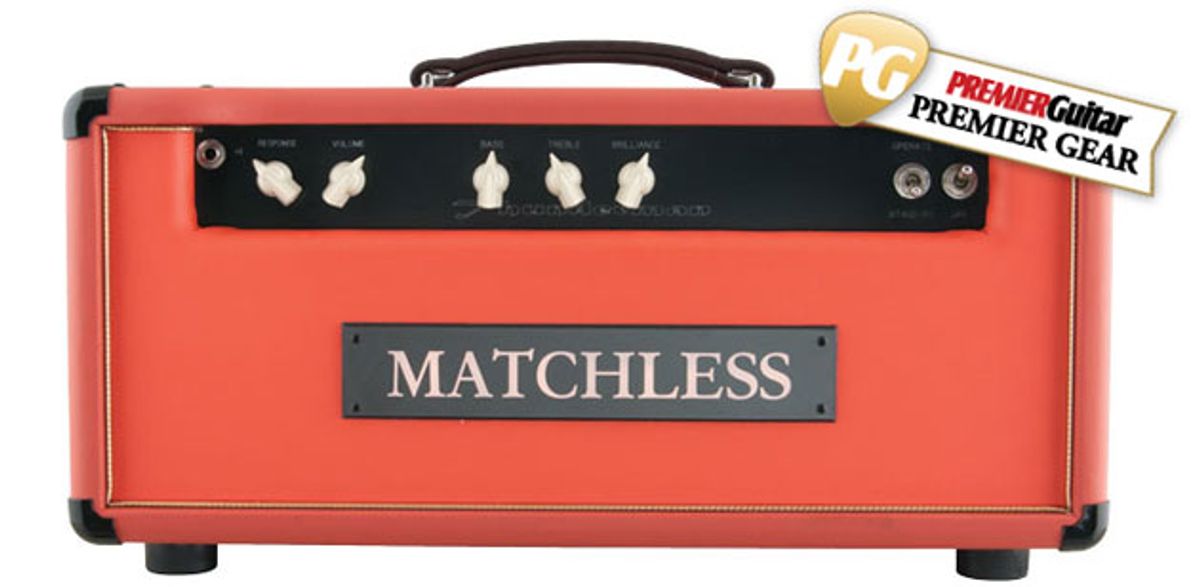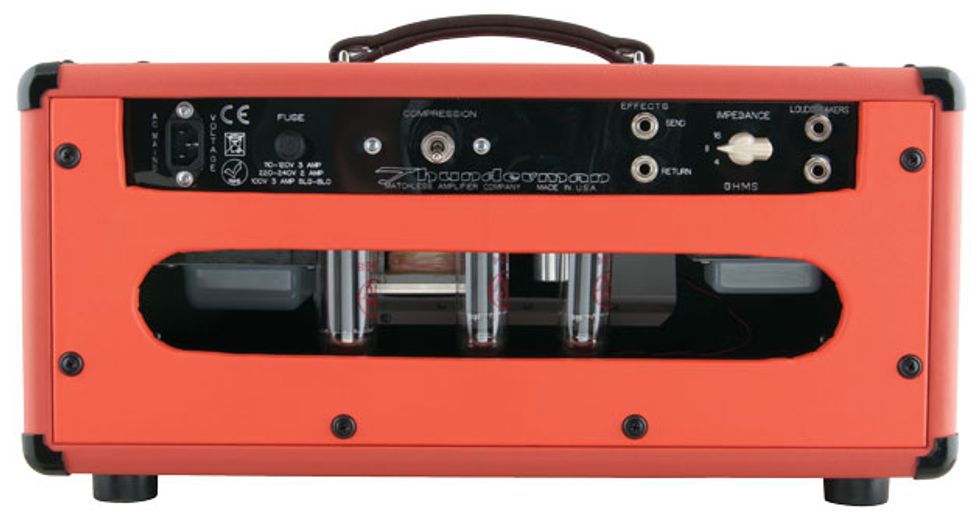
The triumphant return of a classic bass amp inspired by another classic bass amp.
In the world of boutique bass gear, original Matchless Thunderman amps are the stuff of legend. The 45- and 100-watt models produced in small numbers in the late ’90s have a tone and a removable latching head design influenced by the famous Ampeg B-15 flip-top combos of the ’60s. Engineers and session musicians prize these amps for their rich, velvety studio tone, which requires little tweaking after hitting the console. And while these amps don’t pack the mammoth power of an SVT, gigging players love how they spread the low end evenly throughout the room, creating the effect of a much bigger amp. Unfortunately, originals are as rare as hen’s teeth and often carry a hefty price tag, which makes the reintroduction of the Thunderman all the more enticing.
The new Thunderman is a meticulously hand-assembled head that share some traits with the original 45-watt model. This time around, however, the amp is packaged in a stylish, vinyl-covered head shell, and comes stock with EL34s rather than the original’s 6L6s. (There is no longer a flip-top option.)
A Real Head Case
The Thunderman’s attractive looks, sturdy build, and straightforward controls are textbook lessons in simplicity. The burnt sienna covering (other colors are available) and brightly lit Matchless logo capture attention from across the room. You can really feel the amp’s quality and workmanship when carting it around by its leather handle.
Inside the head shell is a completely point-to-point hand-wired circuit. Two 12AX7 preamp tubes feed into a class-A power section for a total of 45 watts. A 5U4G rectifier tube provides warm, bubbly sag.
The simple controls—response (gain), volume, bass, treble, and brilliance (presence)— may lack the wide-ranging versatility that modern bassists are used to having at their fingertips, but the clean layout makes it a cinch to dial up great tones on the fly. The back panel houses a rotary impedance knob and a series effects loop. There’s also a compression switch—similar to the one on the original Thunderman 45—that engages a solid-state rectifier, tightening low-end response for slaphappy playing styles. You can really feel the quality and workmanship of this small, 55-pound amp when carting it around by its leather handle.
Thunder and Lightning
Wielding a Fender Jazz Bass with the amp running through a 1978 Sunn 2x15 cab, I set the EQ controls flat and the response control at around 9 o’clock. I was greeted by a warm, balanced clean tone with spanky highs. The midrange was very responsive to changes in attack, alleviating my initial concerns about the amp not having a dedicated midrange control. Harder fingerpicking caused the midrange to bloom with a gnarlier and more aggressive edge. Switching to a lighter attack relaxed the mids and eased the focus of the highs, effectively morphing from a classic rock tone to a smoother R & B sound.
Ratings
Pros:
Masterful handmade build. Great sensitivity and low-end spread. Versatile, easy-to-use EQ. Excellent compressor. Less expensive than a ’90s original.
Cons:
No flip-top combo option.
Tones:
Playability/Ease of Use:
Build/Design:
Value:
Street:
$2,200
Matchless Thunderman
matchlessamplifiers.com
The ranges of the Thunderman’s EQ and response controls are quite wide, offering a diverse palette of warm tube tones. The EQ controls are interactive—adjusting one affects the others. Turning up the treble, for example, not only adds highs, but decreases lows. Interactive controls can be frustrating on amps with many EQ knobs, but here there’s not much of a learning curve. I easily dialed up myriad tones ranging from bottom-heavy Jack Bruce-style boom to tight, warm James Jamerson-inspired thump.
Turning the response knob above 3 o’clock offered a bit of grind if I wanted it, but the control was much more effective for loosening or tightening the amp’s overall response. The tone was more focused and the lows carried less when at settings below 11 o’clock, but the sound gained sustain and breadth when I raised the control to 1 o’clock and beyond.
The compression switch is one of the Thunderman’s most useful features. It evens out volume with respect to pick attack. Particularly nice is the fact that it doesn’t completely squash the amp’s dynamics, as outboard bass compressors can do if set improperly. It allowed my sound to rise and fall ever so slightly in response to softer or harder picking, without a trace of unwanted coloration. The trade-off is that the level drops slightly. There are no available adjustments for the function, so you’re stuck with the preset configuration. But thankfully, it’s near-perfect.
The Verdict
The new Thunderman marks the welcome return of one of the most coveted Matchless amps. It captures the tone, feel, and majestic low-end spread that make the originals so remarkable. The tone is to die for, and the amp’s robust build and classy looks make it reliable and eye-catching. The simple EQ layout makes it easy to dial up great tones. The built-in compressor can even out the volume bumps of heavy picking. Bassists looking for maximum power may need to look elsewhere. But if love the warm, gooey tones that only a low-wattage tube amp can provide, the Thunderman is right up your alley.



